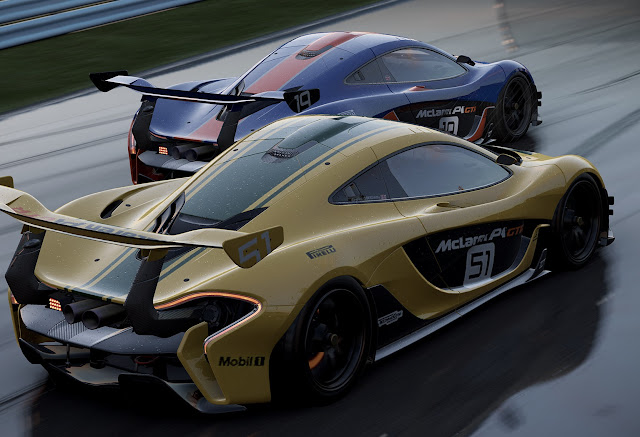Preview by Matt S.
Project Cars 2, the sequel to the quite phenomenal hardcore racing game simulator, is out in around a month now, and while most people don’t seem to think I’m a fan of racing games (I’m not sure how many of these things I need to play before people will come to that conclusion, but there you go), it’s a game I’m really looking forward to. I’m not great at racing games when they get to the point that they’re this serious, but I really enjoyed Project Cars, and the idea of a game building on that was always going to be enough to grab my attention.
Related reading: Matt’s review of the original Project Cars.
I was able to get some hands-on time with the very ultimate in the Project Cars 2 experience. Bandai Namco, the local publisher of the game, held a session with the game running on DBOX full motion simulators (provided by Racecentre, a Sydney-based racing simulator experience company that will be running Project Cars 2 for the public once released). One DBOX unit was VR enabled (Project Cars 2 supports HTC Vive and Oculus Rift, but sadly no PlayStation VR). The other was a three-screen setup. Both were completely immersive, and for anyone who has never experienced one of these units before; the DBOX aims to give you the complete car racing experience, with the seat itself moving and shuddering with every crash, collision, and bump in the road. These units would cost around $40,000 to set up for yourself, so it’s the not the kind of experience that you’ll get to play in in your typical lounge room, but it was nevertheless impressive to see just how authentic the racing experience in Project Cars 2 can be.
Across the dozens and dozens of tracks, and endless stream of car models to choose between, I got to test out a half dozen different cars and tracks, as well as some of the weather conditions. The first thing that is immediately noticeable is that this game is presented far better than Project Cars was. Environments are more detailed and attractive, and although it must be said that there are still better looking racing games out there, the cars themselves in Project Cars 2 are absolutely gorgeous. Small details like the wheels distorting thanks to the suspension system really give the engine an authenticity that makes the photo and replay modes really enjoyable to watch, even if the trees and spectators look a bit like cheap, fuzzy bits of scenery from a bygone era at times.
There’s also new ways to race, which is exciting. The most demanding of all is the ice racing; a real event, apparently, in which crazy people try to steer their cars, quickly, to a finish line over roads covered in ice that offer no grip. If you’re able to do well in this mode, then you really are a racing game master. For slightly easier challenges you’re able to set just about any weather condition you could think of, from sunny to dark, fog through to thunderstorm, and really test yourself against the elements.
Something intriguing that really impacted me when playing in VR, especially, was the way the game would blur your vision as you accelerated quickly. This is designed to replicate the impact of G-forces on real-life racers in their overpowered cars, and I can’t remember it being a feature of Project Cars, or any other racing game I’ve ever played. It can make judging turns incredibly difficult – or even just spotting them – and introduces the need to really practice on a track before you can hope to be really competitive on it. You can turn this off if you’d like – indeed, as with the first Project Cars complete customisation is the focus, and you can do anything from a completely arcade-like racing to a hardcore simulation through the game’s options – but I recommend leaving it on. It’s a very believable effect.
Actually getting good at Project Cars 2 is going to take a lot of practice, and that applies to each individual car, as they all handle substantially differently, another bit of realism, of course, and one that fans of specific cars will really appreciate. There’s a firm focus on multiplayer racing in this one, as it’s possible to create championships, and there’s a number of Twitch streaming options built natively into the game, such as the ability for one “player” to instead be an observer of the race, choosing camera angles and being able to talk to the audience like a commentary team. It has fascinated me that there hasn’t been a breakaway hit among racing games in eSports, yet, but Project Cars 2 has the potential to be that game, especially taking into account that pure skill alone is all that’s going to get you to the finish line.
I really enjoyed the original Project Cars, and this sequel is a clear improvement in every way. I came away utterly impressed by how completely accurate the physics engine was, and as a result, just how good it felt to be weaving in between the (surprisingly intelligent) AI, and sliding around corners. I wasn’t great at it, and spun out far too often; I’ve clearly got to put some hard yards back in to get my racing mojo back, but it’s going to be a challenge that I relish in a month or so when I get my hands on the final release.
And if you can, get along to Racecentre and play Project Cars 2 on one of those DBOX systems. It’s really the best thing you could hope for this side of actually being on the real-life track.
– Matt S.
Editor-in-Chief
Find me on Twitter: @digitallydownld
 |
| Please Support Me On Patreon!
|









